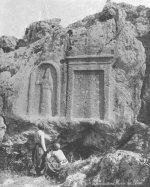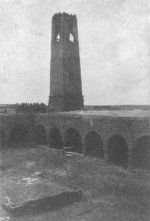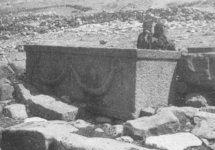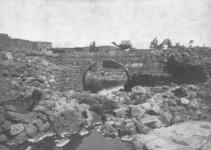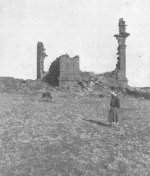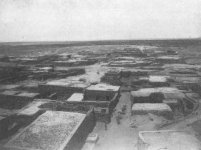Wanted to share a few images found in the book titled "The Giant Cities of Bashan and Syria's Holy Places." The book was written by Josias Leslie Porter, and first published in 1865.

1823-1889
Josias Leslie Porter was an Irish Presbyterian minister, missionary and traveler, who became an academic administrator. After being educated privately, between 1835 and 1838, by Samuel Craig, presbyterian minister of Crossroads, County Londonderry, and then at a school in Derry, he matriculated in the University of Glasgow in 1839, with a view to entering the ministry of the Irish presbyterian church. He graduated B.A. in 1841, and M.A. in 1842. In November 1842 he went to the university of Edinburgh, where he studied theology under Thomas Chalmers, continuing also to the Divinity Hall of the Free Church of Scotland, again to study under Chalmers.
The image of Josias Leslie Porter, provided by the Wikipedia, proved to be the only one I could find. This is pretty bizarre, considering that he died in 1889.
As far as I understand, Genesis 14 talks about certain events that transpired in the region referred to as Bashan. Genesis 14 also talks about the Rephaim aka the Giants.
Now, let's go back to the book authored by Josias Leslie Porter.

Here, I primarily wanted to show the sketches presented in the book. But before we go to the images, let's see if the author ever claimed that he actually observed the structures depicted in the book.


If you believe that structures built 4,000 years ago were/are still around, I have a bridge to sell you. For me, the construction of the presented buildings happened fairly recently. What's your opinion on that? Here is Mr. Porter describing the condition and state of the structures he observed.

Made me think of Joshua 24:13.

To be honest, just reading some of the things shared in this book gives me goose bumps. Mr. Porter was honored to experience something we could only dream of. How long ago were these "long ages" in reality?

Anyways, here are the sketches I wanted to share with you. Just remember, that these structures allegedly belong to the Genesis time frame.







KD: Some of these structures do remind me of Baalbek, but Baalbek is way northeast from the region of Bashan. Yet, it's hard not to consider that the entire region, including Baalbek, was populated by individuals of the same size.
Here is an image of Baalbek I have never seen before. Ran into it while putting this article together. Allegedly, it's an entrance into the alleged Temple of Jupiter.
I really wanted to see some sketches of the actual undamaged cities of the Bashan region described by Mr. Porter, but we were not shown any. Was it the censorship, or Mr. Porter was making stuff up... I do not know, but I find it hard to believe that he was lying.
Here is the 1932 view from the Castle of Salcah aka Salkhad. What happened there?
Yet, here are some of the structures that were still present in the general area around 1900.


Would love to see the entire collection of photographs they took in 1900. These are limited to the ones I extracted from the PDF file.
1823-1889
- Porter was licensed to preach by the presbytery of Derry in 1844.
- He was ordained in 1846, and until 1849 was minister of the presbyterian congregation of High Bridge, Newcastle-on-Tyne.
- He was then sent to Damascus as a missionary to the Jews by the board of missions of the Irish Presbyterian church.
- He reached Syria in December 1849, and remained there for ten years.
The image of Josias Leslie Porter, provided by the Wikipedia, proved to be the only one I could find. This is pretty bizarre, considering that he died in 1889.
Bashan
Bashan is the ancient, biblical name used for the northernmost region of the Transjordan during the Iron Age. It is situated in modern-day Syria. Its western part, nowadays known as the Golan Heights, was captured by Israel during the 1967 Six Day War and annexed in 1981.- Bashan is mentioned 59 times in the Hebrew Bible.
- It is the location of Ashtaroth Karnaim and Edrei (modern-day Daraa).
- Biblical tradition holds that an Amorite kingdom in Bashan was conquered by the Israelites during the reign of King Og.
- Throughout the monarchic period, Bashan was contested between the kingdoms of Israel and Aram-Damascus.
- The name fell out of use in classical antiquity, in which the region was divided into four districts: Batanaea, Gaulanitis, Trachonitis and Auranitis.
- Bashan - Wikipedia
As far as I understand, Genesis 14 talks about certain events that transpired in the region referred to as Bashan. Genesis 14 also talks about the Rephaim aka the Giants.
- In the Hebrew Bible, "Rephaites" or "Repha'im" can describe an ancient race of giants in Iron Age Israel, or the places where these individuals were thought to have lived.
- According to Genesis 14:5, King Chedorlaomer and his allies attacked and defeated the Rephaites at Ashteroth-Karnaim.
- Rephaite - Wikipedia
- Ashteroth Karnaim - Wikipedia
Now, let's go back to the book authored by Josias Leslie Porter.
- I gave you a land on which you had not labored and cities that you had not built, and you dwell in them. You eat the fruit of vineyards and olive orchards that you did not plant.
- And when the LORD your God brings you into the land that he swore to your fathers, to Abraham, to Isaac, and to Jacob, to give you—with great and good cities that you did not build, and houses full of all good things that you did not fill, and cisterns that you did not dig.
- Unfortunately, we will not be able to see the actual cities and houses described in the cutouts above.
- No sketches of the actual 200-500 building cities were provided.
- You come to your own conclusion as to why. Below are just some ruined structures.
KD: Some of these structures do remind me of Baalbek, but Baalbek is way northeast from the region of Bashan. Yet, it's hard not to consider that the entire region, including Baalbek, was populated by individuals of the same size.
Here is an image of Baalbek I have never seen before. Ran into it while putting this article together. Allegedly, it's an entrance into the alleged Temple of Jupiter.
- There are quite a few photographs of Baalbek dated with 1860s-1880s. This is the same general area. How come there are none from similarly dated from the Bashan region?
I really wanted to see some sketches of the actual undamaged cities of the Bashan region described by Mr. Porter, but we were not shown any. Was it the censorship, or Mr. Porter was making stuff up... I do not know, but I find it hard to believe that he was lying.
Here is the 1932 view from the Castle of Salcah aka Salkhad. What happened there?
- Where are those "some thirty towns and villages" observed by Mr. Porter from the castle battlements?
Yet, here are some of the structures that were still present in the general area around 1900.
- The PDF source of the below images is attached to this article.
Would love to see the entire collection of photographs they took in 1900. These are limited to the ones I extracted from the PDF file.
- Where are all these "towns and villages" described in the book?
- If they survived for the alleged "forty centuries," what happened to them between 1850s and 1900-1920s?
- Do we have any photographs of the structures depicted on the sketches above?
- Do we have any photographs of the cities and houses observed by Mr. Porter?


